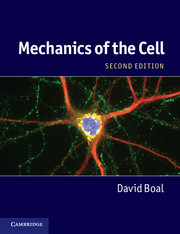Book contents
- Frontmatter
- Contents
- Preface
- List of symbols
- 1 Introduction to the cell
- 2 Soft materials and fluids
- Part I Rods and ropes
- Part II Membranes
- Part III The whole cell
- Appendix A Animal cells and tissues
- Appendix B The cell’s molecular building blocks
- Appendix C Elementary statistical mechanics
- Appendix D Elasticity
- Glossary
- References
- Index
1 - Introduction to the cell
Published online by Cambridge University Press: 05 June 2012
- Frontmatter
- Contents
- Preface
- List of symbols
- 1 Introduction to the cell
- 2 Soft materials and fluids
- Part I Rods and ropes
- Part II Membranes
- Part III The whole cell
- Appendix A Animal cells and tissues
- Appendix B The cell’s molecular building blocks
- Appendix C Elementary statistical mechanics
- Appendix D Elasticity
- Glossary
- References
- Index
Summary
The number of cells in the human body is literally astronomical, about three orders of magnitude more than the number of stars in the Milky Way. Yet, for their immense number, the variety of cells is much smaller: only about 200 different cell types are represented in the collection of about 1014cells that make up our bodies. These cells have diverse capabilities and, superficially, have remarkably different shapes, as illustrated inFig. 1.1. Some cells, like certain varieties of bacteria, are not much more than inflated bags, shaped like the hot-air or gas balloons invented more than two centuries ago. Others, such as nerve cells, may have branched structures at each end connected by an arm that is more than a thousand times long as it is wide. The basic structural elements of most cells, however, are the same: fluid sheets, sometimes augmented by shear-resistant walls, enclose the cell and its compartments, while networks of filaments maintain the cell’s shape and help organize its contents. Further, the chemical composition of these structural elements bears a strong family resemblance from one cell to another, perhaps reflecting the evolution of cells from a common ancestor; for example, the protein actin, which forms one of the cell’s principal filaments, is found in organisms ranging from yeasts to humans.
- Type
- Chapter
- Information
- Mechanics of the Cell , pp. 1 - 24Publisher: Cambridge University PressPrint publication year: 2012

